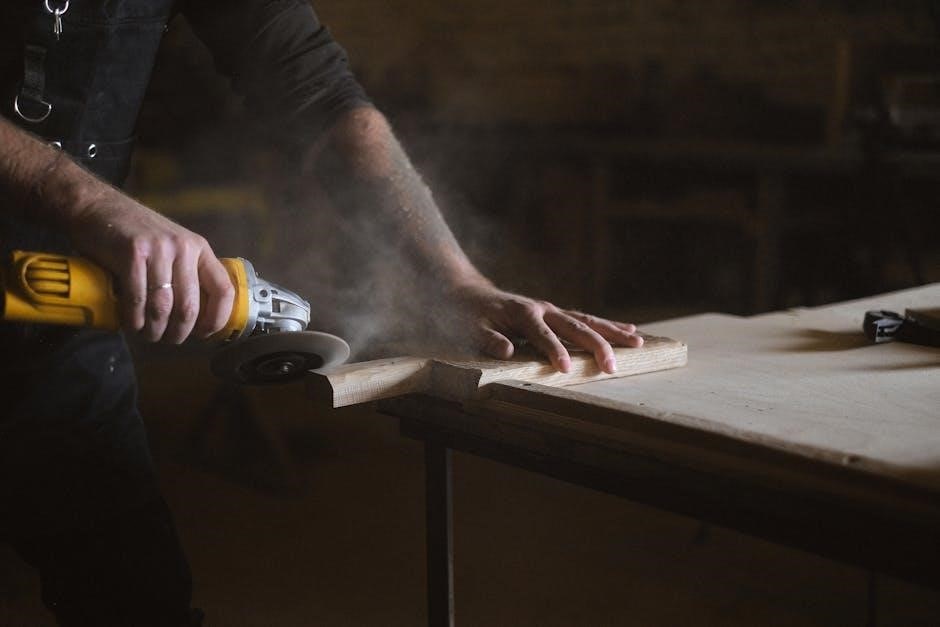1.1 Overview of the Craftsman Pressure Washer
The Craftsman Pressure Washer is a powerful cleaning tool designed for efficiency and versatility, ideal for various surfaces like driveways, decks, and vehicles.
1.2 Importance of Following the Instruction Manual
Reading and adhering to the manual ensures safe operation, proper assembly, and maintenance, maximizing performance and warranty coverage for your Craftsman Pressure Washer.
The Craftsman Pressure Washer is a high-performance cleaning tool designed for versatility and efficiency. With models offering up to 3000 PSI, it tackles tough cleaning tasks on surfaces like driveways, decks, and vehicles. Its durable construction ensures long-lasting reliability, while user-friendly features simplify operation. The pressure washer is compatible with various accessories, including high-pressure hoses and spray tips, enhancing its adaptability for different cleaning needs. Whether for heavy-duty projects or light household chores, the Craftsman Pressure Washer delivers consistent results. Its eco-friendly design and energy-efficient features make it a practical choice for homeowners and professionals alike. Regular maintenance and proper usage, as outlined in the manual, ensure optimal performance and extend the product’s lifespan.
Following the instruction manual is crucial for safe and effective operation of the Craftsman Pressure Washer. It provides essential safety precautions to prevent accidents and ensures proper assembly and maintenance. The manual outlines guidelines for selecting the right spray tips and adjusting pressure settings, which are vital for optimal performance. By adhering to the manual, users can avoid potential damage to the equipment and surfaces being cleaned. Additionally, it helps maintain warranty coverage by ensuring the pressure washer is used as intended. Regular maintenance tasks, such as checking hoses and pumps, are also detailed to prolong the product’s lifespan. Ignoring the manual may lead to improper usage, reducing efficiency and increasing the risk of malfunctions. Always refer to the manual for troubleshooting common issues and ensuring eco-friendly operation.

Pre-Operation Checklist
Before using the Craftsman Pressure Washer, ensure all safety precautions are followed, unpack and inventory all parts, and complete assembly as instructed; Regularly inspect hoses, connections, and spray tips for damage or wear to ensure safe and efficient operation.
2.1 Safety Precautions and Warnings
Always wear personal protective equipment, including rubber boots and eye protection, to prevent injury from high-pressure jets or debris. Keep the pressure washer away from open flames or sparks, as certain chemicals may ignite. Never aim the nozzle at people, pets, or windows, as the high pressure can cause harm or damage. Avoid using bleach or flammable liquids in the detergent tank, as they can create hazardous fumes. Ensure the area is well-ventilated and avoid operating the washer in confined spaces. Regularly inspect hoses and connections for damage or leaks to prevent accidents. Follow all safety guidelines in the manual to ensure safe and effective operation of your Craftsman Pressure Washer.
2.2 Unpacking and Inventory of Parts
Carefully unpack the Craftsman Pressure Washer and verify all components against the manual’s parts list. Ensure the main unit, high-pressure hose, spray gun, and nozzles are included. Check for any visible damage during unpacking. Inspect the detergent tank, wheels, and handle for proper assembly. Compare the unpacked items with the manual’s inventory to confirm nothing is missing. If any parts are damaged or absent, contact customer support immediately. Properly organizing the parts will streamline the assembly process. Familiarize yourself with each component’s purpose to ensure correct installation. This step is crucial for safe and effective operation of your Craftsman Pressure Washer. Always refer to the manual for detailed descriptions of each part.
2.3 Assembly Instructions
Begin by attaching the handle to the main unit using the provided bolts. Ensure it is securely tightened for stability. Next, connect the high-pressure hose to the pump outlet and the spray gun. Attach the spray nozzle to the gun, selecting the appropriate tip for your needs. If your model includes a detergent tank, mount it according to the manual’s instructions. Check all connections for leaks and ensure they are tightly secured. Refer to the manual’s exploded diagrams for visual guidance. Once assembled, test the pressure washer at a low setting to ensure proper function. Always wear protective gloves during assembly to prevent injury. Proper assembly is critical for safe and efficient operation. Follow the manual’s step-by-step instructions carefully to avoid errors.

Operating the Pressure Washer
Start the engine, pull the recoil handle, and allow it to warm up briefly. Use the spray gun with the correct tip for your cleaning task. Adjust pressure settings as needed and apply detergent if required. Always maintain a safe distance from surfaces and wear protective gear.
3.1 Starting the Pressure Washer
Before starting, ensure the pressure washer is on a flat surface and all connections are secure. Pull the recoil handle gently to engage the engine. Allow the engine to warm up for about 30 seconds. If your model has a choke, ensure it is in the correct position. Once the engine runs smoothly, squeeze the spray gun trigger to release any air from the system. Avoid pulling the trigger while the engine is cold to prevent damage; Always wear safety goggles and keep loose clothing tied back. Refer to the manual for specific starting procedures for your model. Never exceed the recommended PSI setting.
3.2 Selecting and Using Spray Tips
Selecting the right spray tip is crucial for effective cleaning. The Craftsman Pressure Washer comes with interchangeable tips, each designed for specific tasks. A 25° tip is ideal for general cleaning, while a 0° tip is best for heavy-duty cleaning. Always choose the tip that matches your surface type to avoid damage. To install, pull the spray gun trigger to release pressure, then twist and lock the tip into place. Avoid using the wrong tip, as it may reduce efficiency or damage the equipment. Test the spray pattern on a small area first. For delicate surfaces, use a wider-angle tip to prevent excessive pressure concentration. Always wear safety goggles when changing tips. Refer to the manual for tip compatibility and usage guidelines.
3.3 Adjusting Pressure Settings
Adjusting the pressure settings on your Craftsman Pressure Washer ensures optimal cleaning without damaging surfaces. Start by setting the pressure to the lowest recommended level for your task. Use the regulator knob located near the pump to increase or decrease pressure. For delicate surfaces like siding or windows, keep the pressure below 1,500 PSI. For tougher tasks like concrete or heavy stains, higher settings up to 3,000 PSI may be necessary. Always test a small, inconspicuous area first to ensure the setting is appropriate. Excessive pressure can strip paint or damage materials. Refer to the manual for specific guidelines tailored to your model and task requirements. Proper adjustment enhances cleaning efficiency and protects both the washer and the surface being cleaned.

Maintenance and Troubleshooting
Regular maintenance and troubleshooting are crucial for optimal performance and longevity of your Craftsman Pressure Washer. Ensure proper care and address issues promptly to maintain efficiency.
4.1 Regular Maintenance Tasks
Regular maintenance ensures your Craftsman Pressure Washer operates efficiently and extends its lifespan. Check the oil level in the engine regularly and replace it as recommended. Inspect the high-pressure hose for signs of wear or damage and replace it if necessary. Clean or replace the filter to prevent blockages and maintain water flow. Check all connections for leaks and tighten them as needed. After each use, drain the hose and pump to prevent water damage. Store the pressure washer in a dry, protected area during winter months. Refer to the manual for specific maintenance schedules and procedures to keep your unit in optimal condition. Regular upkeep prevents costly repairs and ensures consistent performance.
4.2 Common Issues and Solutions
Common issues with the Craftsman Pressure Washer include low water pressure, engine not starting, or leaks. For low pressure, check for kinked hoses, blockages, or incorrect spray tips. If the engine won’t start, ensure there’s sufficient oil and the choke is properly set. Leaks often occur from loose connections or worn seals, which can be tightened or replaced. Regularly check and clean the filter to prevent clogs. Refer to the manual for troubleshooting specific error codes or unusual noises. Addressing these issues promptly ensures optimal performance and prevents further damage. Always follow the manufacturer’s guidelines for repairs to maintain warranty coverage and safety.

Accessories and Attachments
The Craftsman Pressure Washer supports various accessories, including high-pressure hoses, spray tips, and detergent injectors. These attachments enhance cleaning efficiency for different surfaces and tasks;
5.1 High-Pressure Hose Installation
To install the high-pressure hose, first ensure all connections are clean and free of debris. Attach one end of the hose to the pressure washer’s outlet, aligning the quick-connect coupler. Secure it firmly by pushing and twisting until it clicks. Next, connect the other end to the spray gun or wand, following the same quick-connect method. Tighten any threaded connections by hand to avoid overtightening. After installation, turn on the pressure washer briefly to check for leaks. If leaks occur, re-tighten the connections. Always refer to the manual for model-specific instructions to ensure proper installation and safety. Proper installation ensures optimal performance and prevents damage to the equipment.
5.2 Using Detergents and Chemicals
When using detergents or chemicals with your Craftsman Pressure Washer, ensure they are specifically designed for pressure washers to avoid damaging the system. Add detergent to the designated tank, following the manufacturer’s instructions for the correct dosage. Avoid using harsh chemicals like bleach or muriatic acid, as they can corrode internal components. Always wear protective gloves and eyewear when handling chemicals. For tough stains, apply the detergent directly to the surface and let it sit before rinsing. Eco-friendly options are recommended to minimize environmental impact. After use, dispose of any leftover chemicals responsibly. Proper usage ensures effective cleaning while maintaining the longevity of your pressure washer. Always refer to the manual for compatibility guidelines.

Safety Guidelines
Adhere to safety guidelines when operating the Craftsman Pressure Washer. Always wear PPE, including rubber boots and eye protection. Avoid using the washer in unsafe environments.
6.1 Personal Protective Equipment (PPE)
Wearing proper PPE is crucial when operating the Craftsman Pressure Washer; Always use safety glasses or goggles to protect your eyes from debris. Wear rubber boots or slip-resistant shoes to prevent accidents. Gloves are recommended to maintain a firm grip and avoid abrasions. Ensure loose clothing or jewelry is secured to avoid entanglement with the machine. Never operate the washer without protective eyewear, as high-pressure jets can cause severe injury. Additionally, avoid wearing open-toed shoes or sandals. Failure to use PPE may result in serious harm or exposure to chemicals. Always check for any additional safety gear recommended in the manual. Proper PPE ensures a safer and more controlled cleaning experience.
6.2 Proper Usage in Different Environments
Using your Craftsman Pressure Washer in various settings requires adjustments for optimal performance and safety. In residential areas, ensure the noise level is manageable and avoid spraying windows or delicate plants. For commercial use, higher PSI settings may be necessary, but always test a small area first; When cleaning vehicles, use a wide fan tip to prevent paint damage. On concrete surfaces, maintain a consistent distance to avoid uneven cleaning. In industrial settings, wear additional PPE like ear protection. Always follow the manual’s guidelines for different environments to ensure effective cleaning and prevent damage. Proper usage in diverse settings enhances cleaning efficiency and prolongs equipment life.

Technical Specifications
The Craftsman Pressure Washer features a robust 3000 PSI rating, 2.4 GPM flow rate, and a durable axial cam pump. Compatible with various attachments for enhanced cleaning efficiency;
7.1 Pressure Washer Models and PSI Ratings
Craftsman offers various pressure washer models with differing PSI ratings, such as the CMEPW1900 (3000 PSI) and the 580.752 (also 3000 PSI), designed for diverse cleaning tasks. These models deliver a 2.4 GPM flow rate, ensuring efficient cleaning for light to heavy-duty jobs. The 3000 PSI rating is ideal for tackling tough stains on surfaces like driveways, decks, and vehicles. Higher-rated models may include additional features like adjustable pressure settings and detergent injection systems. Always refer to the manual to ensure the selected model aligns with your specific cleaning needs. Proper PSI selection prevents surface damage while optimizing results.
7.2 Compatible Accessories and Parts
Craftsman pressure washers support a variety of accessories to enhance functionality. High-pressure hoses, spray tips, and detergent injection systems are commonly compatible. These parts ensure optimal performance and versatility. Accessories like extension wands and rotating nozzles are also available, catering to specific cleaning tasks. Always use genuine Craftsman parts to maintain warranty and performance. Refer to the manual for a complete list of compatible accessories. Proper installation and usage of these parts ensure safety and efficiency. Links to download detailed compatibility charts are provided in the manual for easy reference. This ensures you find the right tools for your cleaning needs.

Environmental Considerations
Using eco-friendly detergents and minimizing water usage helps reduce environmental impact. Proper disposal of chemicals ensures safety for the environment and aligns with sustainability practices.
8.1 Eco-Friendly Usage Tips

To minimize environmental impact, use eco-friendly detergents that are biodegradable and free of harsh chemicals. Opt for lower pressure settings when possible to conserve water. Avoid unnecessary washing of surfaces to reduce water and detergent usage. Properly dispose of any leftover chemicals according to local regulations to prevent contamination. Regularly maintain your pressure washer to ensure efficiency and reduce waste. By following these tips, you can help protect the environment while effectively cleaning various surfaces. Always refer to the manual for additional eco-friendly recommendations tailored to your Craftsman Pressure Washer model.
8.2 Proper Disposal of Chemicals
Properly dispose of any leftover detergents or chemicals used with your Craftsman Pressure Washer by following local regulations. Do not pour chemicals down drains or storm sewers, as they can harm aquatic life. Check with your local waste management facility for designated drop-off locations for hazardous materials. Always store chemicals in their original containers with labels intact. Dispose of empty containers responsibly, ensuring they are completely empty and dry. Never mix different chemicals, as this can create dangerous reactions. By adhering to these guidelines, you help protect the environment and ensure compliance with local laws. Always refer to the manual for specific recommendations on chemical disposal.

Warranty and Support
The Craftsman Pressure Washer is backed by a one-year limited warranty covering defects in materials and workmanship. For support, contact customer service via phone, email, or the official website.
9.1 Warranty Coverage and Duration
The Craftsman Pressure Washer is covered by a one-year limited warranty from the date of purchase. This warranty protects against defects in materials and workmanship under normal use and maintenance. During this period, defective parts will be repaired or replaced free of charge, provided the unit has been operated according to the instruction manual. The warranty does not cover damage resulting from misuse, neglect, or unauthorized modifications. To maintain warranty validity, ensure all maintenance tasks outlined in the manual are performed regularly. For warranty claims or inquiries, contact Craftsman customer support through their official website or phone. Proper documentation, including proof of purchase, may be required.
9.2 Contacting Customer Support
For assistance with your Craftsman Pressure Washer, contact customer support through multiple channels. Visit the official Craftsman website for live chat, email support, or phone contact options. Phone support is available Monday through Friday, 8 AM to 5 PM EST. When reaching out, have your model number, purchase date, and a detailed description of your issue ready. Support agents can help with troubleshooting, warranty claims, or replacement parts. Additionally, FAQs and troubleshooting guides are available online to address common issues quickly. Ensure to use authorized service centers for repairs to maintain warranty coverage. Prompt and professional assistance is provided to resolve any concerns effectively.
10.1 Final Tips for Optimal Performance
Regularly maintain your Craftsman Pressure Washer and follow safety guidelines for optimal performance and longevity.
10.2 Encouragement to Refer Back to the Manual
Refer to this manual for troubleshooting or operation questions, ensuring safe and effective use of your pressure washer.
To ensure your Craftsman Pressure Washer operates at its best, always follow the manual’s maintenance schedule and safety guidelines. Regularly inspect hoses, nozzles, and seals for wear. Use recommended detergents to avoid damaging the pump or surfaces. Store the unit in a dry, protected area during winter to prevent freezing. For tough stains, allow detergent to sit before rinsing. Never exceed the recommended PSI for specific surfaces. Keep the area clear of debris to avoid clogs. Refer to the manual for troubleshooting common issues like low pressure or engine problems. By following these tips, you’ll extend the lifespan of your pressure washer and maintain its efficiency. Always prioritize safety and proper usage.
Regularly revisiting the manual ensures you stay informed about best practices, safety measures, and maintenance tips for your Craftsman Pressure Washer. It serves as a comprehensive guide to troubleshooting common issues and optimizing performance. By referring back, you can avoid potential damage from improper use and ensure warranty coverage remains valid. The manual also provides clarity on assembly, operation, and storage, helping you maintain the unit’s efficiency over time. Keep it handy for quick reference, especially when encountering unfamiliar tasks or resolving operational problems. This resource is designed to enhance your experience and prolong the lifespan of your pressure washer. Make it a habit to consult the manual whenever questions arise.
